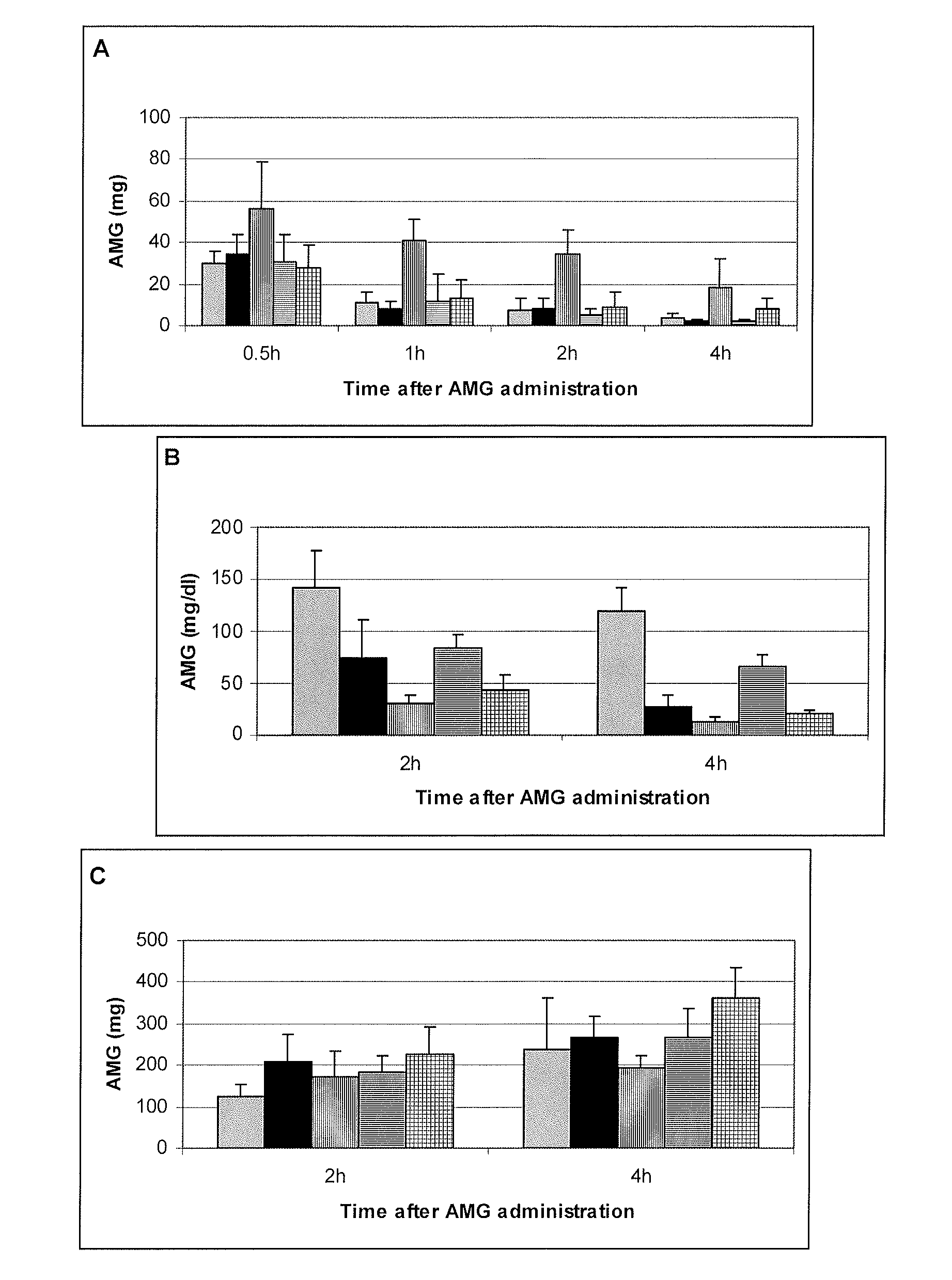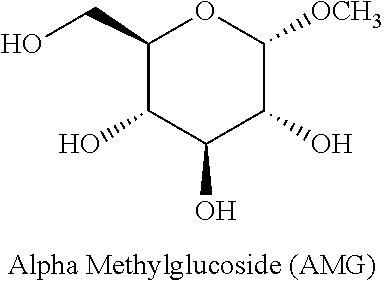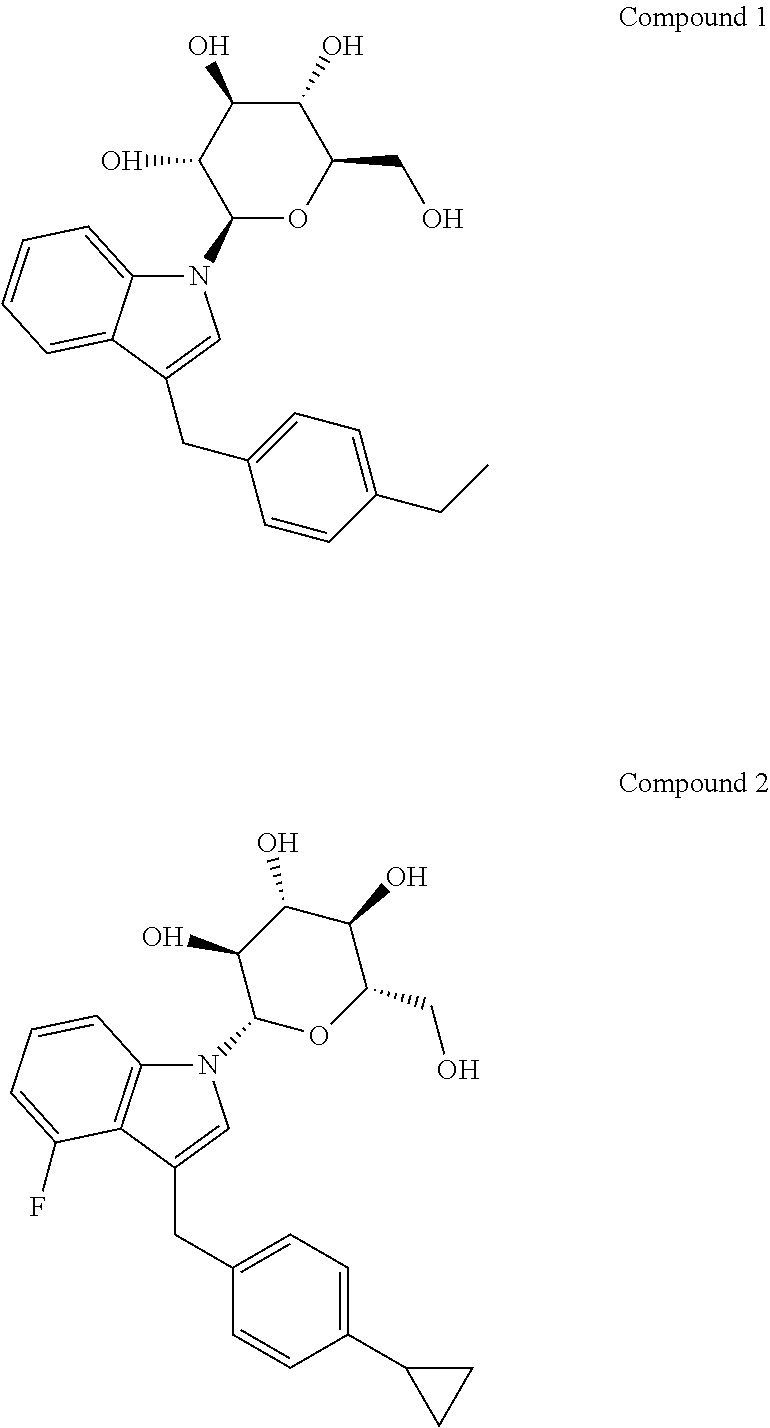Methods of using alpha-methylglucoside (AMG) as an indicator for glucose absorption and excretion
a technology of alpha-methylglucoside and glucose absorption, which is applied in the direction of material analysis, biological material analysis, instruments, etc., can solve the problems of preventing the subsequent measurement of amg in blood, urine or other tissues, and the unattractiveness of phlorizin itsel
- Summary
- Abstract
- Description
- Claims
- Application Information
AI Technical Summary
Benefits of technology
Problems solved by technology
Method used
Image
Examples
example 1
Cell-based Assays
[0066]Inhibition of SGLT activity with Compound 1 and Compound 2 was assessed in CHOK1 cells stably expressing either human SGLT1 or human SGLT2. Compound 1 and Compound 2, are described in U.S. Patent Application Nos. 2005 / 0233988 and 2008 / 0027122, the contents of which are incorporated by reference in their entirety.
[0067]
[0068]CHOK1 cells expressing human SGLT2 or human SGLT1 were seeded in 24-well plates at a density of approximately 400,000 cells / well in F-12 nutrient mixture (Ham's F-12) containing 10% fetal bovine serum, 400 ug / ml Geneticin, 50 units / ml sodium penicillin G (Gibco-BRL) and 50 ug / ml streptomycin sulfate. Cells were maintained in culture for 2 days at 37° C. in a humidified atmosphere containing 5% CO2. On the day of the assay, Compound 1 and Compound 2 were dissolved in DMSO and then diluted in assay buffer. The final concentration of DMSO was 0.5%. Assay buffer contained 137 mM NaCl, 5 mM KCl, 1 mM CaCl2, 1 mM MgCl2, 50 mM Hepes, and 20 mM Tri...
example 2
Animal Studies
[0070]Male Sprague-Dawley (SD) rats were dosed by oral gavage with either vehicle, 0.5% methylcellulose (methocel) in sterile water, or one of the SGLT inhibitors (Compound 1 and Compound 2) at 0.3 or 3.0 mg / kg. Compounds were administered as a suspension in 0.5% methylcellulose and sterile water. One hour after dosing the animals with the compounds, AMG was administrated orally via gavage (2 g / kg). AMG was dissolved in sterile water. Rats were sacrificed 120 or 240 minutes after AMG administration. Urine and plasma samples were collected and the entire gastrointestinal tract was removed and placed into saline. Subsequently, a GI lysate was made. Aliquots were taken from the samples of plasma, urine and the GI lysate and were extracted with acetonitrile to precipitate protein. It was desirable to remove the protein because the different biofluids contain greatly differing amounts of protein. The protein signal could have rendered more difficult the quantification of th...
example 3
[0071]Proton NMR spectra were acquired on a Bruker DMX 600 MHz NMR spectrometer (Bruker Biospin Corporation, Billerica, Mass.) with the probe temperature maintained at 32° C. The mildly elevated temperature was used to enhance the chemical shift separation between the solvent peak (the residual water in the sample) and the anomeric proton of AMG (a doublet at 4.80 ppm) which was used for quantification. The solvent peak was saturated using very low power irradiation (a field strength of about 4 Hz) during the pre-pulse delay followed by a 30° pulse to acquire the signal. The pre-pulse delay was 3.0 s and the acquisition time was 2.1 s. The sweep width was 13 ppm using 32 k complex points. Before fourier transformation the data was apodized with 0.5 Hz exponential linebroadening. The amount of AMG present in the sample was determined relative to an internal reference, DSS (2,2-dimethyl-2-silapentane-d6-sulfonic acid, sodim salt) at 0.00 ppm.
[0072]The in vivo resu...
PUM
 Login to View More
Login to View More Abstract
Description
Claims
Application Information
 Login to View More
Login to View More - R&D
- Intellectual Property
- Life Sciences
- Materials
- Tech Scout
- Unparalleled Data Quality
- Higher Quality Content
- 60% Fewer Hallucinations
Browse by: Latest US Patents, China's latest patents, Technical Efficacy Thesaurus, Application Domain, Technology Topic, Popular Technical Reports.
© 2025 PatSnap. All rights reserved.Legal|Privacy policy|Modern Slavery Act Transparency Statement|Sitemap|About US| Contact US: help@patsnap.com



